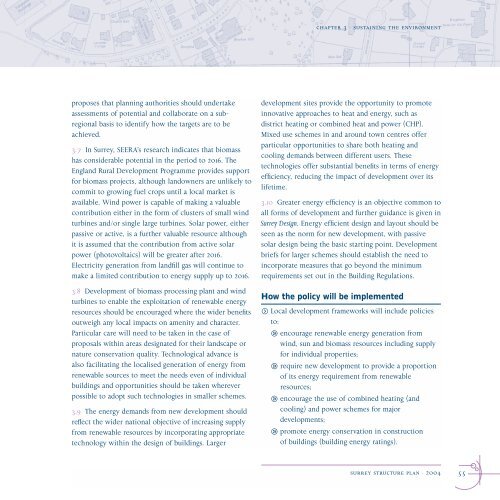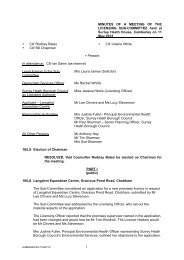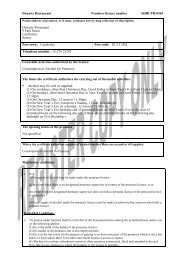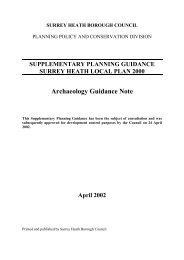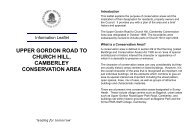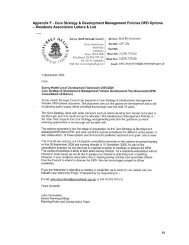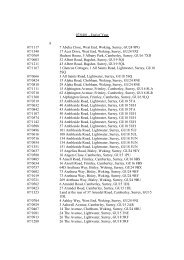SURREY STRUCTURE PLAN 2004 - Surrey County Council
SURREY STRUCTURE PLAN 2004 - Surrey County Council
SURREY STRUCTURE PLAN 2004 - Surrey County Council
Create successful ePaper yourself
Turn your PDF publications into a flip-book with our unique Google optimized e-Paper software.
chapter 3 · sustaining the environment<br />
proposes that planning authorities should undertake<br />
assessments of potential and collaborate on a subregional<br />
basis to identify how the targets are to be<br />
achieved.<br />
3.7 In <strong>Surrey</strong>, SEERA’s research indicates that biomass<br />
has considerable potential in the period to 2016. The<br />
England Rural Development Programme provides support<br />
for biomass projects, although landowners are unlikely to<br />
commit to growing fuel crops until a local market is<br />
available. Wind power is capable of making a valuable<br />
contribution either in the form of clusters of small wind<br />
turbines and/or single large turbines. Solar power, either<br />
passive or active, is a further valuable resource although<br />
it is assumed that the contribution from active solar<br />
power (photovoltaics) will be greater after 2016.<br />
Electricity generation from landfill gas will continue to<br />
make a limited contribution to energy supply up to 2016.<br />
3.8 Development of biomass processing plant and wind<br />
turbines to enable the exploitation of renewable energy<br />
resources should be encouraged where the wider benefits<br />
outweigh any local impacts on amenity and character.<br />
Particular care will need to be taken in the case of<br />
proposals within areas designated for their landscape or<br />
nature conservation quality. Technological advance is<br />
also facilitating the localised generation of energy from<br />
renewable sources to meet the needs even of individual<br />
buildings and opportunities should be taken wherever<br />
possible to adopt such technologies in smaller schemes.<br />
3.9 The energy demands from new development should<br />
reflect the wider national objective of increasing supply<br />
from renewable resources by incorporating appropriate<br />
technology within the design of buildings. Larger<br />
development sites provide the opportunity to promote<br />
innovative approaches to heat and energy, such as<br />
district heating or combined heat and power (CHP).<br />
Mixed use schemes in and around town centres offer<br />
particular opportunities to share both heating and<br />
cooling demands between different users. These<br />
technologies offer substantial benefits in terms of energy<br />
efficiency, reducing the impact of development over its<br />
lifetime.<br />
3.10 Greater energy efficiency is an objective common to<br />
all forms of development and further guidance is given in<br />
<strong>Surrey</strong> Design. Energy efficient design and layout should be<br />
seen as the norm for new development, with passive<br />
solar design being the basic starting point. Development<br />
briefs for larger schemes should establish the need to<br />
incorporate measures that go beyond the minimum<br />
requirements set out in the Building Regulations.<br />
How the policy will be implemented<br />
f Local development frameworks will include policies<br />
to:<br />
g encourage renewable energy generation from<br />
wind, sun and biomass resources including supply<br />
for individual properties;<br />
g require new development to provide a proportion<br />
of its energy requirement from renewable<br />
resources;<br />
g encourage the use of combined heating (and<br />
cooling) and power schemes for major<br />
developments;<br />
g promote energy conservation in construction<br />
of buildings (building energy ratings).<br />
surrey structure plan · <strong>2004</strong> 55


